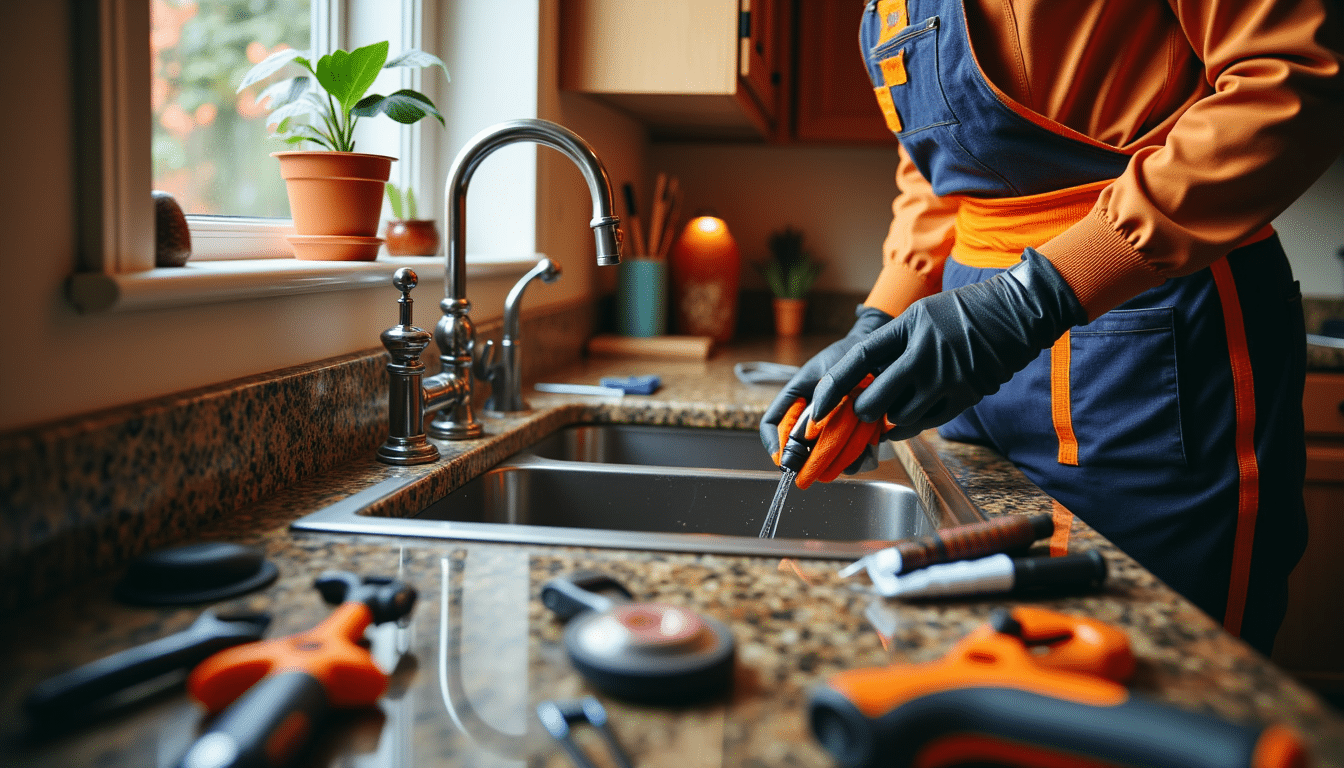Common Causes of Blocked Drains
Before diving into solutions, it helps to understand what’s causing the problem. In my experience across Lancashire homes, these are the usual suspects:
- Kitchen sinks: Food waste, cooking oil and grease solidifying in pipes
- Bathroom drains: Hair, soap scum and toothpaste residue
- Toilets: Excessive toilet paper or flushing items that shouldn’t go down there
- Outdoor drains: Leaves, soil, and garden debris
Understanding the likely culprit can help you choose the most effective unblocking method.

Essential Tools for DIY Drain Unblocking
Before starting, gather these household drainage solutions:
- Rubber gloves (this isn’t going to be pretty)
- Plunger (flat for sinks, bellied for toilets)
- Drain snake or auger
- Bicarbonate of soda and vinegar
- Kettle for boiling water
- Bucket
- Old towels
Having everything ready before you start will make the job much smoother.

Method 1: The Hot Water Flush
I always recommend starting with the simplest solution. For minor blockages, especially grease-based ones in kitchen sinks, this often does the trick:
- Boil a full kettle of water
- Pour it directly down the drain in one steady stream
- Wait 5 minutes and repeat if necessary
Safety note: Don’t use this method if you have PVC pipes under your sink, as the extreme heat could damage them. And never pour boiling water into a porcelain toilet bowl as it can crack.
Method 2: The Plunger Technique
A good plunger creates pressure that can dislodge many blockages:
- Ensure there’s enough water to cover the plunger’s rubber cup
- For sinks, block the overflow with a damp cloth
- Place the plunger directly over the drain hole, creating a seal
- Pump vigorously for about 20-30 seconds
- Pull away sharply to break the vacuum
In my renovation work, I’ve found that older homes in Lancashire often have more complex plumbing configurations, so you might need to be more persistent with the plunger in heritage properties.
Method 3: Bicarbonate of Soda and Vinegar
This natural drain cleaning solution works brilliantly for soap and grease blockages:
- Pour half a cup of bicarbonate of soda down the drain
- Follow with half a cup of white vinegar
- Cover the drain with a plug or cloth
- Let it fizz for 30 minutes
- Flush with hot water
The chemical reaction creates a natural foaming action that can break down many common blockages. I’ve used this on countless heritage properties where harsh chemicals might damage original pipework.

Method 4: The Drain Snake
For stubborn blockages, particularly hair in bathroom drains, a drain snake (or auger) is your best friend:
- Insert the end of the snake into the drain
- Turn the handle clockwise, pushing it further in until you feel resistance
- Rotate the snake against the blockage to break it up or hook it
- Slowly pull the snake back out, bringing the debris with it
- Flush with hot water
You can purchase a basic drain snake from most UK hardware shops for under £20 – well worth the investment for any homeowner.
Method 5: Remove and Clean the U-Bend
If the methods above haven’t worked, it’s time to get your hands dirty:
- Place a bucket underneath the U-bend (the curved pipe under your sink)
- Unscrew the connectors on either side of the U-bend
- Remove it and clear out any debris
- Rinse thoroughly before reattaching
- Ensure connectors are tightened properly to prevent leaks
This is particularly effective for kitchen sinks where food particles can accumulate. In older Lancashire homes, I often find decades of residue in these bends!
Dealing with Outdoor Drains
External drainage problems require a slightly different approach:
- Lift the drain cover (use a screwdriver if needed)
- Wear thick gloves and remove any visible debris
- Pour a bucket of hot water down to flush away remaining matter
- For deeper blockages, drain rods can be effective
Regular clearing of outdoor drains, especially during autumn when leaves are falling, can prevent more serious blockages.

When to Call a Professional
While DIY drain unblocking works for many situations, some scenarios warrant professional help:
- Multiple drains blocked simultaneously
- Recurring blockages despite clearing
- Sewage backing up into your home
- Unusual gurgling sounds from pipes
- Strong, persistent odours
These could indicate more serious issues with your main sewer line or drainage system. According to Water UK, around 300,000 sewer blockages occur annually in the UK, with many caused by issues that require professional intervention.
Preventing Future Blockages
As with most home maintenance issues, prevention is better than cure:
- Install drain guards to catch hair and food particles
- Never pour cooking oil or fat down sinks (collect in a container and dispose of it properly)
- Regularly flush drains with hot water
- Consider a monthly maintenance clean with bicarbonate of soda and vinegar
- Only flush toilet paper and human waste down toilets
For more comprehensive advice on preventing plumbing emergencies, check out our guide on how to prevent common household plumbing problems.
Environmental Considerations
One final thought that’s close to my heart after years of working with Lancashire’s historic homes – try to avoid harsh chemical drain cleaners. They can:
- Damage older pipework
- Harm the environment
- Be dangerous if mixed with other household chemicals
- Sometimes make blockages worse by hardening them
The natural and mechanical methods outlined above are usually effective enough without resorting to aggressive chemicals.
A Final Word from the Trenches
After decades of dealing with drainage issues in homes across Lancashire, from Georgian townhouses to modern apartments, I’ve learned that patience is often as important as technique when unblocking drains. Don’t rush the process, and don’t be tempted to use excessive force – you might end up with a bigger problem than you started with.
Keep a drain snake and plunger in your household toolkit, and you’ll be prepared for most blockage emergencies. And remember, if you’re renting, persistent drain issues should be reported to your landlord or letting agent, as they may indicate larger problems with the property’s plumbing system.
For more home maintenance advice tailored to the unique challenges of UK properties, explore our complete guide to seasonal home maintenance or learn about tackling damp problems in older homes.
Have you successfully tackled a challenging drain blockage? Share your experiences in the comments below – your tips might just save a fellow homeowner from a plumbing disaster!






